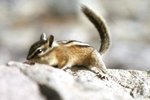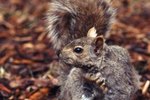
Squirrels are found in many regions of the world, including Europe, Asia and the Americas. There are many varieties of squirrel, and some species have at times been considered endangered or threatened. Today the most common varieties are the grey squirrel, western grey squirrel, red squirrel and California ground squirrel. Squirrels are primarily diurnal, gathering food during the day and resting at night. They generally are less active during the winter but do not hibernate.
Behavior and Feeding
Squirrels are forest dwellers. They primarily eat nuts and seeds, but will also eat berries, fungus and insects. Squirrels horde food in small amounts in several locations when it's abundant. Some caches of seeds are never recovered and instead become seedlings.
Nests
Squirrels construct their nests out of twigs and leaves, with grass and leaves lining the inside. They will place these nets, known as dreys, along branches or on buildings. Squirrels may have multiple dreys, and may also use holes in tree trunks and stumps as temporary shelters. There are two varieties of drey; one is an open platform just used for sleeping, and the other is a covered shelter used for birthing and raising young. Some varieties of squirrels, such as ground squirrels, may dig burrows or build dreys in low, concealed locations.
Territory
Squirrels are highly territorial and vocal. They are especially noisy during mating season, and they generally breed twice a year. Some species of squirrels may claim as much as 10 hectares of territory. Because of the high density of squirrels in most habitats, there is sometimes significant territory overlap. Squirrels mark their territory with urine and tail-waving displays, and they may bark warning calls at passing intruders, including humans. Most squirrels live in colonies or groups, but some, like the grey squirrel, are solitary creatures.
Habitat Loss
Squirrels have many predators, but their main threats are habitat loss and human competition. The western grey squirrel was considered a threatened species due to disease and road-kill, though its population has recovered. Habitats suffer from urbanization and wild fires, and the intrusion of foreign plants such as scotch broom prevents the regrowth of squirrels' natural habitats.
References
Resources
Photo Credits
-
Ablestock.com/AbleStock.com/Getty Images
Writer Bio
Kyle Turpin has been writing for eight years. He has written articles for publication on eHow that cover topics such as customizing operating systems, level and game design, and science and technology. He specializes in informative writing, as well as fiction and poetry. He has studied Physics as well as English at the University of Victoria and is aspiring to become a published author.



